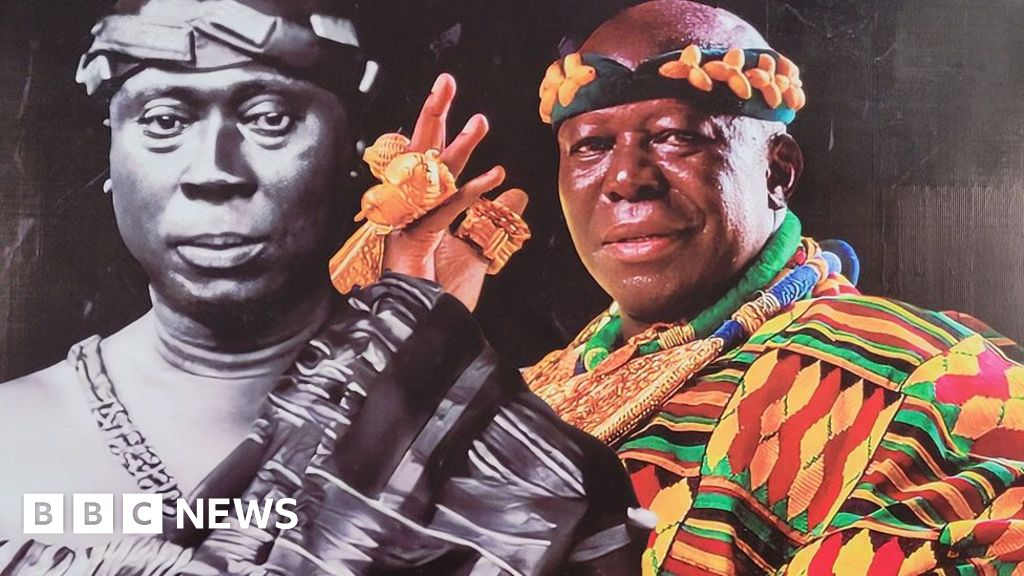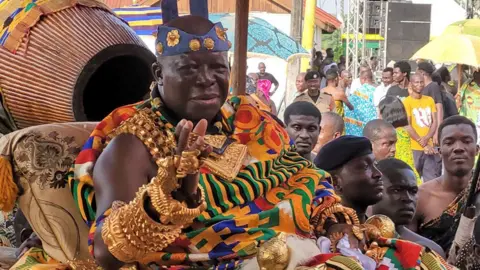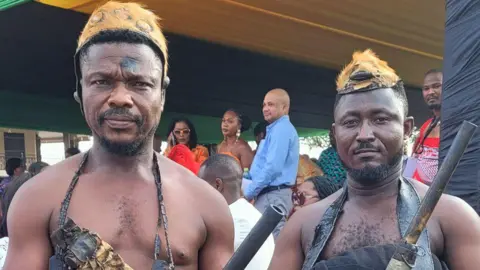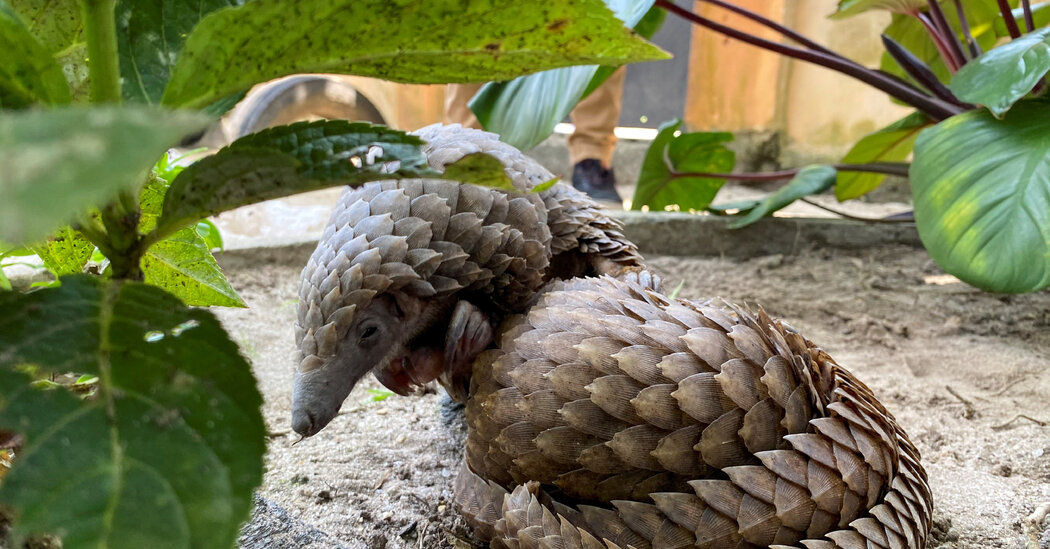
 Barnaby Phillips
Barnaby PhillipsThe garden out of doors the royal palace within the Ghanaian town of Kumasi was once full of an cheerful people, celebrating the go back 100 years in the past of an exiled king.
Prempeh was once the Asante king, or “Asantehene”, of the past due nineteenth Century who resisted British calls for that his area be swallowed up into the increasing Gold Coast protectorate.
A British military from the coast marched about 200km (124 miles) to Kumasi in 1896, and took Prempeh in addition to about 50 kinfolk, chiefs and servants as prisoners, and nearest looted his palace.
The prisoners have been taken to the coastal citadel at Elmina, ahead of being shipped to Sierra Leone, and, in 1900, directly to the separate Indian Ocean islands of Seychelles.
It was once no longer till 1924 that the British allowed Prempeh to go back house, through which life he was once an aged guy who arrived in Kumasi dressed in a Ecu swimsuit and hat.
This is a catastrophic tale, but in addition one in all pleasure and resistance.
“The British did all they could but they couldn’t break the spirit of Asante,” shouted the grasp of ceremonies. The stream Asantehene, Osei Tutu II, was once paraded on his palanquin throughout the people, weighed unwell by way of grand gold jewelry, amid a shining cacophony of musket explosions, drum beats and the blare of horns produced from elephant tusks.
Asante tradition is alive and neatly.
 Barnaby Phillips
Barnaby PhillipsHowever Prempeh’s exile did have an enduring have an effect on on each the Asante kingdom and Seychelles, even though most likely no longer in tactics meant by way of British officers on the life.
The visitor of proclaim on the centenary celebrations, held in Kumasi on the weekend, was once Seychelles’ President Wavel Ramkalawan, who mentioned “it was an honour, though sad, for us to receive your great king”.
“He showed respect to our people, and in return received the full love of the Seychelles,” Ramkalawan added.
The evidence of this is in crowd ties loved to this month.
Princess Mary Prempeh Marimba is Prempeh’s great-grand-daughter. Her grandfather, James, the son of Prempeh, married a Seychellois lady, and first of all stayed at the islands next his father left.
Mary is a nursing manager in Seychelles’ capital, Victoria, and travelled to Kumasi together with her daughter Suzy, to re-unite with dozens of long-lost kinfolk and uncover extra about her Asante heritage.
“There are so many mixed emotions, my great-grandfather had so many difficulties, and this is a sad history, but I also come here and celebrate with my family,” she mentioned.
The Asante exiles in Seychelles lived in “Ashanti Town”, on an used sugar plantation, Le Rocher, at the primary island Mahé, overlooking the sea and surrounded by way of coconut, mango, breadfruit, orange and jackfruit timber.
Prempeh lived within the property’s villa, and was once given “every respect and dignity”, in line with Dr Penda Uneven, a Seychellois instructional who additionally travelled to Kumasi for the centenary occasions.
In 1901, the Asante folk grew, as Yaa Asantewaa, a queen who led the overall resistance to the British, and a few 20 chiefs and attendants, have been additionally despatched to Seychelles following their give up.
 Barnaby Phillips
Barnaby PhillipsThe lengthy years of exile modified Prempeh. He learnt to learn and scribble, and instructed the Asante youngsters to wait faculty.
He embraced Christianity, and, within the phrases of Asante historian and flesh presser Albert Adu Boahen, “rigidly and uncompromisingly imposed that religion on his fellow political prisoners and their children”.
Within the Anglican Church of St Paul’s, the Asante weren’t the one exiles within the congregation, for they ceaselessly sat with King Mwanga of Buganda and King Kabalega of Bunyoro, each from modern day Uganda.
Certainly, at diverse occasions, the British additionally despatched political prisoners from Egypt, Palestine, Zanzibar, the Maldives, Malaysia and Cyprus to Seychelles, which was once referred to as a “prison without bars”, as its isolation made the very best location, from the British viewpoint, to place difficult fighters.
The years went by way of, and Prempeh dreamt of house.
In 1918, he wrote to King George V and pleaded to be allowed to go back.
“Consider how wretched I am for I was being taken prisoner… for now 22 years, and now how miserable to see that father, mother, brother and nearly three quarters of the chiefs are dead. The remaining quarter, some are blind, some worn out with old age and the rest being attacked of diverse diseases,” Prempeh wrote.
A couple of years next, the British, most likely conscious that Prempeh’s attainable demise in exile may just deliver political issues in Asante, after all relented.
In November 1924 Prempeh travelled by way of send again to West Africa with some 50 Asante partners, maximum of whom were born in Seychelles.
“We who do not know him are more than anxious to see his face,” wrote a well-known native newspaper, The Gold Coast Chief.
In Kumasi, many slept by way of the educate station to greet him and, in line with a British professional, “the scene presented by the huge assembly…. with their white head bands signifying rejoicing or victory, some laughing and cheering, while others wept with emotion, was a most moving and never-to-be-forgotten sight”.
In principle “Mr Edward Prempeh” was once now a non-public citizen, however his population handled him as a king, and introduced him with royal regalia, together with the Yellowish Stool, mentioned to comprise the soul of the Asante population.
 Barnaby Phillips
Barnaby PhillipsPrempeh died in 1931, and his successor, Prempeh II, was once restored to the location of Asantehene in 1935.
Ivor Agyeman-Duah, an Asante pupil and director of the palace museum, helped organise the centenary celebrations.
They have been of added non-public use, as his good grandfather, Kwame Boatin, was once one of the most chiefs exiled along Prempeh.
However as Mr Agyeman-Duah recognizes, exile, for all its ache, additionally introduced alternatives for many who suffered it.
Kwame Boatin’s youngsters went directly to be ambassadors and chief civil servants, in a position to evolve to the dramatic adjustments that Asante, the Gold Coast and next an isolated Ghana, underwent within the twentieth Century.
“The exiles had been exposed to the world, and they had something to contribute,” he mentioned. “What they brought back still inspires us, their dedication to scholarship and public service.”
In a village one era’s force from Kumasi, I met Princess Molly Prempeh, an animated girl in her 80s, and in addition a great-granddaughter of Prempeh.
“I’m the only remaining person here who was born in Seychelles,” she instructed me.
“I’m Seychellois and Ghanaian – I was five years old when I came back.”
In her used generation, Molly has reconnected with the pretty islands of her beginning, and visited two times.
The Seychellois are thrilled by way of the “Old Creole”, which contains extra French phrases, she recalls from adolescence.
“When I walk down the streets they shout ‘Heh Princess, how are you?’ ‘Princess, venez, venez, tu bien?’ (come, come here, you good?) they are lovely people. They love the Prempehs in Sesel (Seychelles).”
However Molly’s visits also are tinged with unhappiness. She is going to the grave of her mom, Hugette, who introduced Molly as a tender woman to the Gold Coast in 1948.
Hugette next returned to Seychelles, the place she ultimately died.
Even in her used generation, the tale is going, she beloved to talk the Twi language she were taught as a minute woman by way of Prempeh herself.
One crowd’s tale of loss, exile and perpetuity.
Barnaby Phillips is a former BBC correspondent and creator of Loot; Britain and the Benin Bronzes
Extra BBC tales about Ghana:
 Getty Photographs/BBC
Getty Photographs/BBC












